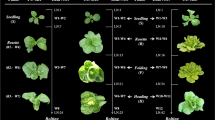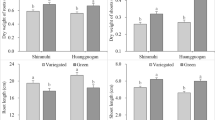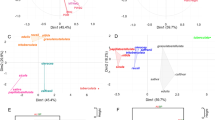Abstract
C4 and C3 photosynthesis differ in the efficiency with which they consume water and nitrogen. Engineering traits of the more efficient C4 photosynthesis into C3 crops could substantially increase crop yields in hot, arid conditions. To identify differences between C4 and C3 photosynthetic mechanisms, we profiled metabolites and gene expression in the developing leaves of Zea mays (maize), a C4 plant, and Oryza sativa (rice), a C3 plant, using a statistical method named the unified developmental model (UDM). Candidate cis-regulatory elements and transcription factors that might regulate photosynthesis were identified, together with differences between C4 and C3 nitrogen and carbon metabolism. The UDM algorithms could be applied to analyze and compare development in other species. These data sets together with community viewers to access and mine them provide a resource for photosynthetic research that will inform efforts to engineer improvements in carbon fixation in economically valuable grass crops.
This is a preview of subscription content, access via your institution
Access options
Subscribe to this journal
Receive 12 print issues and online access
$209.00 per year
only $17.42 per issue
Buy this article
- Purchase on Springer Link
- Instant access to full article PDF
Prices may be subject to local taxes which are calculated during checkout





Similar content being viewed by others
Change history
16 October 2014
In the version of this article initially published online, reference 20 was incorrect. Instead of Piganeau et al., J. Mol. Evol. 69, 249–259 (2009), the correct reference is Vandepoele et al., Plant Physiol. 150, 535–546 (2009).The error has been corrected for the print, PDF and HTML versions of this article.
26 October 2014
The version of this article initially published online was incorrectly listed as an Article. It is a Resource. The error has been corrected for the print, PDF and HTML versions of this article.
References
Sage, R.F., Sage, T.L. & Kocacinar, F. Photorespiration and the evolution of C4 photosynthesis. Annu. Rev. Plant Biol. 63, 19–47 (2012).
Hibberd, J.M. & Covshoff, S. The regulation of gene expression required for C4 photosynthesis. Annu. Rev. Plant Biol. 61, 181–207 (2010).
Leakey, A.D. Rising atmospheric carbon dioxide concentration and the future of C4 crops for food and fuel. Proc. Biol. Sci. 276, 2333–2343 (2009).
Wheeler, T. & von Braun, J. Climate change impacts on global food security. Science 341, 508–513 (2013).
Conceição, P. & Mendoza, R.U. Anatomy of the global food crisis. Third World Q. 30, 1159–1182 (2009).
von Caemmerer, S., Quick, W.P. & Furbank, R.T. The development of C(4)rice: current progress and future challenges. Science 336, 1671–1672 (2012).
Weissmann, S. & Brutnell, T.P. Engineering C4 photosynthetic regulatory networks. Curr. Opin. Biotechnol. 23, 298–304 (2012).
Li, P. et al. The developmental dynamics of the maize leaf transcriptome. Nat. Genet. 42, 1060–1067 (2010).
Pick, T.R. et al. Systems analysis of a maize leaf developmental gradient redefines the current C4 model and provides candidates for regulation. Plant Cell 23, 4208–4220 (2011).
Nelson, T. The grass leaf developmental gradient as a platform for a systems understanding of the anatomical specialization of C(4) leaves. J. Exp. Bot. 62, 3039–3048 (2011).
Nunes-Nesi, A., Fernie, A.R. & Stitt, M. Metabolic and signaling aspects underpinning the regulation of plant carbon nitrogen interactions. Mol. Plant 3, 973–996 (2010).
Xu, G., Fan, X. & Miller, A.J. Plant nitrogen assimilation and use efficiency. Annu. Rev. Plant Biol. 63, 153–182 (2012).
Wang, L. et al. A low-cost library construction protocol and data analysis pipeline for Illumina-based strand-specific multiplex RNA-seq. PLoS ONE 6, e26426 (2011).
Hedges, S.B., Dudley, J. & Kumar, S. TimeTree: a public knowledge-base of divergence times among organisms. Bioinformatics 22, 2971–2972 (2006).
Alexa, A., Rahnenfuhrer, J. & Lengauer, T. Improved scoring of functional groups from gene expression data by decorrelating GO graph structure. Bioinformatics 22, 1600–1607 (2006).
Prioul, J.L., Brangeon, J. & Reyss, A. Interaction between external and internal conditions in the development of photosynthetic features in a grass leaf: II. Reversibility of light-induced responses as a function of developmental stages. Plant Physiol. 66, 770–774 (1980).
Miranda, V., Baker, N.R. & Long, S.P. Anatomical variation along the length of the Zea mays leaf in relation to photosynthesis. New Phytol. 88, 595–605 (1981).
Smith, A.M., Zeeman, S.C. & Smith, S.M. Starch degradation. Annu. Rev. Plant Biol. 56, 73–98 (2005).
Mockler, T.C. et al. The DIURNAL project: DIURNAL and circadian expression profiling, model-based pattern matching, and promoter analysis. Cold Spring Harb. Symp. Quant. Biol. 72, 353–363 (2007).
Vandepoele, K., Quimbaya, M., Casneuf, T., De Veylder, L. & Van de Peer, Y. Unraveling transcriptional control in Arabidopsis using cis-regulatory elements and coexpression networks. Plant Physiol. 150, 535–546 (2009).
Kajala, K. et al. Multiple Arabidopsis genes primed for recruitment into C(4) photosynthesis. Plant J. 69, 47–56 (2012).
Lyons, E. & Freeling, M. How to usefully compare homologous plant genes and chromosomes as DNA sequences. Plant J. 53, 661–673 (2008).
Corpet, F. Multiple sequence alignment with hierarchical clustering. Nucleic Acids Res. 16, 10881–10890 (1988).
Mehrotra, R. et al. Effect of copy number and spacing of the ACGT and GT cis elements on transient expression of minimal promoter in plants. J. Genet. 84, 183–187 (2005).
Yanagisawa, S. & Schmidt, R.J. Diversity and similarity among recognition sequences of Dof transcription factors. Plant J. 17, 209–214 (1999).
Wingler, A., Walker, R.P., Chen, Z.H. & Leegood, R.C. Phosphoenolpyruvate carboxykinase is involved in the decarboxylation of aspartate in the bundle sheath of maize. Plant Physiol. 120, 539–546 (1999).
Nomura, M. et al. Differential expression pattern of C4 bundle sheath expression genes in rice, a C3 plant. Plant Cell Physiol. 46, 754–761 (2005).
Zinger, L., Coissac, E., Choler, P. & Geremia, R.A. Assessment of microbial communities by graph partitioning in a study of soil fungi in two Alpine meadows. Appl. Environ. Microbiol. 75, 5863–5870 (2009).
Wang, L., Peterson, R.B. & Brutnell, T.P. Regulatory mechanisms underlying C(4) photosynthesis. New Phytol. 190, 9–20 (2011).
Tilman, D., Balzer, C., Hill, J. & Befort, B.L. Global food demand and the sustainable intensification of agriculture. Proc. Natl. Acad. Sci. USA 108, 20260–20264 (2011).
Yilmaz, A. et al. GRASSIUS: a platform for comparative regulatory genomics across the grasses. Plant Physiol. 149, 171–180 (2009).
Chang, Y.M. et al. Characterizing regulatory and functional differentiation between maize mesophyll and bundle sheath cells by transcriptomic analysis. Plant Physiol. 160, 165–177 (2012).
Ranathunge, K., Schreiber, L. & Franke, R. Suberin research in the genomics era-New interest for an old polymer. Plant Sci. 180, 399–413 (2011).
Eastman, P.A.K., Dengler, N.G. & Peterson, C.A. Suberized bundle sheaths in grasses (Poaceae) of different photosynthetic types. 1. Anatomy, ultrastructure and histochemistry. Protoplasma 142, 92–111 (1988).
Kotula, L., Ranathunge, K., Schreiber, L. & Steudle, E. Functional and chemical comparison of apoplastic barriers to radial oxygen loss in roots of rice (Oryza sativa L.) grown in aerated or deoxygenated solution. J. Exp. Bot. 60, 2155–2167 (2009).
Schreiber, L., Franke, R., Hartmann, K.D., Ranathunge, K. & Steudle, E. The chemical composition of suberin in apoplastic barriers affects radial hydraulic conductivity differently in the roots of rice (Oryza sativa L. cv. IR64) and corn (Zea mays L. cv. Helix). J. Exp. Bot. 56, 1427–1436 (2005).
Zeier, J., Ruel, K., Ryser, U. & Schreiber, L. Chemical analysis and immunolocalisation of lignin and suberin in endodermal and hypodermal/rhizodermal cell walls of developing maize (Zea mays L.) primary roots. Planta 209, 1–12 (1999).
Franke, R. et al. Apoplastic polyesters in Arabidopsis surface tissues–a typical suberin and a particular cutin. Phytochemistry 66, 2643–2658 (2005).
Beisson, F., Li, Y.H., Bonaventure, G., Pollard, M. & Ohlrogge, J.B. The acyltransferase GPAT5 is required for the synthesis of suberin in seed coat and root of Arabidopsis. Plant Cell 19, 351–368 (2007).
Compagnon, V. et al. CYP86B1 Is required for very long chain omega-hydroxyacid and alpha,omega-dicarboxylic acid synthesis in root and seed suberin polyester. Plant Physiol. 150, 1831–1843 (2009).
Gou, J.Y., Yu, X.H. & Liu, C.J. A hydroxycinnamoyltransferase responsible for synthesizing suberin aromatics in Arabidopsis. Proc. Natl. Acad. Sci. USA 106, 18855–18860 (2009).
Molina, I., Li-Beisson, Y., Beisson, F., Ohlrogge, J.B. & Pollard, M. Identification of an Arabidopsis feruloyl-coenzyme A transferase required for suberin synthesis. Plant Physiol. 151, 1317–1328 (2009).
Naseer, S. et al. Casparian strip diffusion barrier in Arabidopsis is made of a lignin polymer without suberin. Proc. Natl. Acad. Sci. USA 109, 10101–10106 (2012).
Isaacson, T. et al. Cutin deficiency in the tomato fruit cuticle consistently affects resistance to microbial infection and biomechanical properties, but not transpirational water loss. Plant J. 60, 363–377 (2009).
Yeats, T.H. et al. The identification of cutin synthase: formation of the plant polyester cutin. Nat. Chem. Biol. 8, 609–611 (2012).
Evert, R.F., Russin, W.A. & Bosabalidis, A.M. Anatomical and ultrastructural changes associated with sink-to-source transition in developing maize leaves. Int. J. Plant Sci. 157, 247–261 (1996).
O'Brien, T.P. & Kuo, J. Development of the suberized lamella in the mestome sheath of wheat leaves. Aust. J. Bot. 23, 783–794 (1975).
Zhong, R., Lee, C., Zhou, J., McCarthy, R.L. & Ye, Z.H. A battery of transcription factors involved in the regulation of secondary cell wall biosynthesis in Arabidopsis. Plant Cell 20, 2763–2782 (2008).
Zhou, J., Lee, C., Zhong, R. & Ye, Z.H. MYB58 and MYB63 are transcriptional activators of the lignin biosynthetic pathway during secondary cell wall formation in Arabidopsis. Plant Cell 21, 248–266 (2009).
Javelle, M. et al. Overexpression of the epidermis-specific homeodomain-leucine zipper IV transcription factor OUTER CELL LAYER1 in maize identifies target genes involved in lipid metabolism and cuticle biosynthesis. Plant Physiol. 154, 273–286 (2010).
Lois, R., Dietrich, A., Hahlbrock, K. & Schulz, W. A phenylalanine ammonia-lyase gene from parsley: structure, regulation and identification of elicitor and light responsive cis-acting elements. EMBO J. 8, 1641–1648 (1989).
Rushton, P.J. et al. Interaction of elicitor-induced DNA-binding proteins with elicitor response elements in the promoters of parsley PR1 genes. EMBO J. 15, 5690–5700 (1996).
Palaniswamy, S.K. et al. AGRIS and AtRegNet. a platform to link cis-regulatory elements and transcription factors into regulatory networks. Plant Physiol. 140, 818–829 (2006).
Davuluri, R.V. et al. AGRIS: Arabidopsis gene regulatory information server, an information resource of Arabidopsis cis-regulatory elements and transcription factors. BMC Bioinformatics 4, 25 (2003).
Mustroph, A. et al. Profiling translatomes of discrete cell populations resolves altered cellular priorities during hypoxia in Arabidopsis. Proc. Natl. Acad. Sci. USA 106, 18843–18848 (2009).
Winter, D. et al. An “Electronic Fluorescent Pictograph” browser for exploring and analyzing large-scale biological data sets. PLoS ONE 2, e718 (2007).
Stitt, M. & Heldt, H.W. Generation and maintenance of concentration gradients between the mesophyll and bundle sheath in maize leaves. Biochimica et Biophysica Acta (BBA). Bioenergetics 808, 400–414 (1985).
Hatch, M. & Osmond, C. Compartmentation and transport in C4 photosynthesis. Encyclopedia of plant physiology, New Series 3, 144–184 (1976).
Schnable, P.S. et al. The B73 maize genome: complexity, diversity, and dynamics. Science 326, 1112–1115 (2009).
Mitchell, P.L. & Sheehy, J.E. Supercharging rice photosynthesis to increase yield. New Phytol. 171, 688–693 (2006).
Mallmann, J. et al. The role of photorespiration during the evolution of C4 photosynthesis in the genus Flaveria. Elife e02478 (2014).
Trapnell, C., Pachter, L. & Salzberg, S.L. TopHat: discovering splice junctions with RNA-Seq. Bioinformatics 25, 1105–1111 (2009).
Trapnell, C. et al. Differential analysis of gene regulation at transcript resolution with RNA-seq. Nat. Biotechnol. 31, 46–53 (2013).
Zhang, M. & Leong, H.W. BBH-LS: an algorithm for computing positional homologs using sequence and gene context similarity. BMC Syst. Biol. 6 (suppl. 1), S22 (2012).
Hubbard, T. et al. The Ensembl genome database project. Nucleic Acids Res. 30, 38–41 (2002).
Shi, G., Zhang, L. & Jiang, T. MSOAR 2.0: Incorporating tandem duplications into ortholog assignment based on genome rearrangement. BMC Bioinformatics 11, 10 (2010).
Ostlund, G. et al. InParanoid 7: new algorithms and tools for eukaryotic orthology analysis. Nucleic Acids Res. 38, D196–D203 (2010).
Chen, F., Mackey, A.J., Stoeckert, C.J. Jr. & Roos, D.S. OrthoMCL-DB: querying a comprehensive multi-species collection of ortholog groups. Nucleic Acids Res. 34, D363–D368 (2006).
Götz, S. et al. High-throughput functional annotation and data mining with the Blast2GO suite. Nucleic Acids Res. 36, 3420–3435 (2008).
Crooks, G.E., Hon, G., Chandonia, J.M. & Brenner, S.E. WebLogo: a sequence logo generator. Genome Res. 14, 1188–1190 (2004).
Tohge, T. & Fernie, A.R. Combining genetic diversity, informatics and metabolomics to facilitate annotation of plant gene function. Nat. Protoc. 5, 1210–1227 (2010).
Tohge, T. & Fernie, A.R. Web-based resources for mass-spectrometry-based metabolomics: A user's guide. Phytochemistry 70, 450–456 (2009).
Elliger, C.A., Chan, B.G., Waiss, A.C., Lundin, R.E. & Haddon, W.F. C-glycosylflavones from Zea-mays that inhibit insect development. Phytochemistry 19, 293–297 (1980).
Snook, M.E. et al. New C-4″-hydroxy derivatives of maysin and 3′-methoxymaysin isolated from corn silks (Zea-mays). J. Agric. Food Chem. 43, 2740–2745 (1995).
Tohge, T. et al. Toward the storage metabolome: profiling the barley vacuole. Plant Physiol. 157, 1469–1482 (2011).
Matsuda, F. et al. Dissection of genotype-phenotype associations in rice grains using metabolome quantitative trait loci analysis. Plant J. 70, 624–636 (2012).
Gibon, Y. et al. A robot-based platform to measure multiple enzyme activities in Arabidopsis using a set of cycling assays: Comparison of changes of enzyme activities and transcript levels during diurnal cycles and in prolonged darkness. Plant Cell 16, 3304–3325 (2004).
Sulpice, R. et al. Network analysis of enzyme activities and metabolite levels and their relationship to biomass in a large panel of Arabidopsis accessions. Plant Cell 22, 2872–2893 (2010).
Acknowledgements
We thank J. Schnable for helpful comments and uploading the original sequencing data to the NCBI SRA (SRP018823). This research was supported by the National Science Foundation (IOS-1127017 to T.P.B., T.C.M., P. Liu and R.T.), the National Sciences and Engineering Research Council of Canada (to N.J.P.) and The Max-Planck Society and the European Union Framework 7 Program (3to4) (to A.R.F. and M.S.).
Author information
Authors and Affiliations
Contributions
L.W., M.S., A.R.F. and T.P.B. contributed to the design of the comparative transcriptomics and metabolic profiling, P.L., Y. Si, L.W. and T.P.B. to the design of the unified developmental model, and D.W.B. and T.C.M. to the design of the ELEMENT algorithm. Data visualization tools were developed by R.V.P. and N.J.P. All authors contributed to the design and execution of experiments and to the interpretation of data.
Corresponding author
Ethics declarations
Competing interests
The authors declare no competing financial interests.
Supplementary information
Supplementary Text and Figures
Supplementary Figures 1–11, Supplementary Tables 4–6, 8–9 and 17 and Supplementary Note 1 (PDF 3598 kb)
Supplementary Table 1
Metabolic traits determined across the maize leaf developmental gradient (XLSX 66 kb)
Supplementary Table 2
Metabolic traits determined across the rice leaf developmental gradient (XLSX 21 kb)
Supplementary Table 3
Orthologous genes of maize and rice (XLSX 1145 kb)
Supplementary Table 7
Expression of major C4 carbon shuttle genes (XLSX 11 kb)
Supplementary Table 10
Lipophilic Cell Wall Biosynthesis candidates of maize and rice (XLSX 29 kb)
Supplementary Table 11
Candidate TFs for Suberin biosynthesis in cluster 25 (XLSX 12 kb)
Supplementary Table 12
Cis-elements of Arabidopsis and maize suberin regulatory candidate promoters (XLSX 12 kb)
Supplementary Table 13
RPKM values of maize and rice genes along the leaf gradients (XLSX 21087 kb)
Supplementary Table 14
TopGO enrichment results for Biological processes (XLSX 75 kb)
Supplementary Table 15
TopGO enrichment results for Molecular Functions (XLSX 73 kb)
Supplementary Table 16
TopGO enrichment results for Cellular Component (XLSX 69 kb)
Supplementary Table 18
Anchor genes used for UDM model (XLSX 1325 kb)
Supplementary Note 2
R codes used to construct UDM (ZIP 16 kb)
Rights and permissions
About this article
Cite this article
Wang, L., Czedik-Eysenberg, A., Mertz, R. et al. Comparative analyses of C4 and C3 photosynthesis in developing leaves of maize and rice. Nat Biotechnol 32, 1158–1165 (2014). https://doi.org/10.1038/nbt.3019
Received:
Accepted:
Published:
Issue Date:
DOI: https://doi.org/10.1038/nbt.3019
This article is cited by
-
Comparative Transcriptome Analysis of Hypocotyls During the Developmental Transition of C3 Cotyledons to C4 Leaves in Halimocnemis mollissima Bunge
Journal of Plant Growth Regulation (2024)
-
Delayed leaf greening involves a major shift in the expression of cytosolic and mitochondrial ribosomes to plastid ribosomes in the highly phosphorus-use-efficient Hakea prostrata (Proteaceae)
Plant and Soil (2024)
-
De novo transcriptome assemblies of C3 and C4 non-model grass species reveal key differences in leaf development
BMC Genomics (2023)
-
Comprehensive in silico analysis of the underutilized crop tef (Eragrostis tef (Zucc.) Trotter) genome reveals drought tolerance signatures
BMC Plant Biology (2023)
-
Effects of low nitrogen on seedling growth, photosynthetic characteristics and antioxidant system of rice varieties with different nitrogen efficiencies
Scientific Reports (2023)



